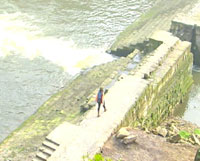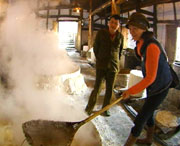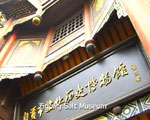Source: CCTV.com
08-15-2006 13:11
cctv.com 03-17-2005 10:15
 | |
Welcome to the Jurassic Park of China! But don't worry, there's no live T-rex roaming around, just a bunch of fossils. I guess a lot of people would probably take issue if their city is called a place of dinosaurs, but not here in Zigong. Because this is where they discovered the most dinosaur fossils in the whole country. Of course the city has a lot more to offer than the dinosaurs, but this is where we are gonna start today!
Unlike my little friends at Beijing, I'd never been to a dinosaur museum before; so my knowledge on the subject is pretty much limited to those 3D images and unsettling howlers created by Hollywood technology.
Located at Dashanpu Township in the northeast suburbs of Zigong, the museum is the third largest dinosaur museum in the world built on the actual fossil site and the largest in Asia.
The museum showcases some 40 complete dinosaur skeletons and over 100 pieces of dinosaur fossils, some of which are one-of-a-kind species. I'm not going to list the tongue-twister like scientific names here, what is more relevant is that the collection is one of the largest, best conditioned, and most valuable worldwide.
Southwest China is one of the most fertile areas for dinosaur digs on the planet; and nowhere else are the relics more abundant than in Zigong. The fossils here at Zigong museum almost covered all the varieties of dinosaurs from the Mid-Jurassic age, a nearly unfathomably long span of time from 210 million years ago to 135 million years ago.
Dashanpu dinosaur locale is also known as a dinosaur cemetery as over 10,000 fossils of nearly 200 dinosaurs and other vertebrates have been excavated from an area of merely 2800 square meters.
Wandering inside this jungle of skeletons, I sort of understand why passion toward dinosaurs only belongs to kids and people who still have a kid's heart.
 | |
Imagine over 200 million years ago, this could well be the paradise for dinosaurs. There are just so many mysteries regarding these gigantic reptiles, for example, how come they just disappeared like overnight from the surface of the earth? And specifically regarding this place Zigong, why did so many different kinds of dinosaurs come to this area and die here? I don't know, and looks like it still remain a mystery even to paleontologists. And probably the biggest mystery regarding Zigong is that they've found so many dinosaur bones here, but not even a single egg! Maybe my little friends can help me here.
Hope that will give paleontologist a clue since there is still no scientific consensus on the question yet. One speculation goes that the dinosaur eggshell from that time period were so thin that they vanished before they could fossilize.
The museum covers only a small segment of the Dashanpu dinosaur quarry. The exploration of the quarry is an on-going project now, as there may be more accumulations of fossils in the area.
The fossils were first spotted by a team of geologists by chance in 1972 and excavated several years later. Scientific research shows that the climate and vegetation of Zigong area during Jurassic Period provide an ideal habitat for dinosaurs; and many dinosaur bodies were carried by the river water to Dashanpu, a calm sand shoal at the time.
Mr. Ye told me that an open-air exhibition hall will be built on the new excavating site where visitors can have some sort of Indiana Jones experience.
 | |
One ancient dam was built way back to transport salt out of Zigong to the rest of the country. Actually, this city is so closely knitted with salt that even its name derives from two different kinds of salt well separated by this river here.
The well salt business in Zigong could be traced back to Han Dynasty almost two thousand years ago. As the salt business prospered, numerous villages and townships were developed during the past millennium. It's not an exaggeration that almost every community here has something to do with salt.
 | |
The boom brought by salt business can be seen literally everywhere in this small town. For example, check out these elaborate buildings, they are known as tongxiang huiguan, sort like a chamber of commerce and clubhouse built by salt businessmen from the same province. During their spare time, they would just gather inside the clubhouse, gamble away the easy money they made from dealing with salt. And if they got too carried away and lost all their money, don't worry. there was a pawnshop just right across the street.
Why did they build such a high threshold? Well, basically, there are two main reasons: first of all, to keep good fortune in and secondly, keep women out. In old times, women wore long skirts and had those small wrapped feet, so it's physically impossible for them to cross the high threshold. Why do they want to do that, we'll find out later.
The site protected by the high threshold is Shenhai salt well, one of the original salt wells and salt workshops left from the 19th century. Well salt is still produced here the old way.
Host: I started to get the hang of it. This is a critical step of making salt, remove the puff from the surface. I really enjoy doing this at this time of the year coz it keeps me warm. The boiling temperature of salt is over 200 degree Celsius. Can you imagine working in summer in this workshop? So in the past, men working in this workshop didn't wear any clothes. That is why women were not allowed to enter!
The production method is quite self-explanatory - using natural gas to boil the bittern until there is only salt left. During the boiling process, soymilk would be added into the bittern to separate foreign substances.
For hundreds of years, Zigong people adopted this simple, yet time consuming and labor intensive method to produce salt. According to the worker here, it takes about eight hours to distill one pan of salt bittern, and yield about 80 kilograms of table salt.
But it is said to be the best table salt you can find in the whole country, at least for making Sichuan style pickles.
Like in most cases, the people sitting in the office always make the most money. The manager's desk was located at a great position to monitor the wooden derrick and the workshop.
The towering wooden derrick of the salt well is almost a symbol of Zigong. Used to be all over the area, nowadays only a few were kept as a tribute to the past.
There is a salt well drilled almost 200 years ago. It's about 1001 meter deep. Can you imagine 200 years ago drilling the well purely by manpower? So it was a world record at the time.
And this is a remake of the original mechanism to show people how 200 yrs ago they drill that 1000 meters salt well. Two groups of workers taking turns jumping over the wooden sticks, using the lever principle to pull up a wooden pole and keep pounding on the exact spot. For every jump, the worker gets one penny paid. And it's the highest paid job among all workers.
A gigantic stone mill-like wheel was used to pull up the bittern over there. It takes 100 turns to pull up just one barrel of bittern. And in the past, the job was not done by men, it was done by bulls.
Host: "Are these salt products all made by the salt from Shenhai deep well?"
Shop Assistant: "yes!"
Host: "Bath salt, salt for foot bathing. I'll get this. I'm sure this will definitely elevate my cooking skill – best salt in the country."
Altogether over 13,000 salt wells were drilled in Zigong using this crude method by generations upon generations of salt workers. The salt well drilling technique is even said to be the forerunner of the modern drilling technology.
The only salt museum in the whole country, but this place is definitely worth a closer look just on its own merit. Check out the architecture.
 | |
The museum is established inside the Shaanxi Guild Hall, an ancient compound built two and a half centuries ago by Shaanxi salt businessmen. From the lavish design of the main entrance, to the superb craftsmanship of the wood and stone sculptures adorning the performing stage and courtyard railings, every detail of the complex testifies to the thriving salt business at the time.
All kinds of tools, it gets really technical here. This museum houses over 400 objects related to salt well drilling. It's the largest collection in the whole country.
Some of the items collected here are really special and valuable, for example, the only complete set of the ancient well drilling tools, contracts, account books and drilling records. My suggestion is going to the Shenhai well first; it will definitely help you to appreciate the museum better.
 | |
Today is the Lantern Festival, the first day to see full moon according to Lunar calendar.
Host: "Tangyuan is the kind of food we eat on Lantern festival."
Foreign tourist: "Taste great!"
Ask any Chinese to name three things about Zigong, it's got to be dinosaur, salt, and, last but not least, Lantern.
The city has a tradition of holding one of the grandest Lantern Festivals in whole country. The ingenious design, impeccable craftsmanship, and enormous volume are almost unparalleled. As a matter of fact, Zigong lantern craftsmen are hot commodities all over the country during Spring Festival.
Zigong promises much more to visitors than its three trademarks. For example, the Big Buddha of Rongxian County to the northwest of the city proper.
 | |
 | |
Here is the second largest Buddha in the country only next to Leshan Buddha also in Sichuan. It stands at 37 meters tall. One of the differences between the two is the hand gesture. For Rongxian Big Buddha, left palm facing up, right palm facing down; and for Leshandafo, both palms are facing down.
The Buddha is yet to become a hot tourist spot eclipsed by the other tourist resource of Zigong, may not be a bad thing for Buddhists pilgrims after all.
Sichuan Province is known for having kept many ancient little towns, of course Zigong is not an exception. Just 11 kilometers southeast to Zigong downtown, right next to the Fuxi River, lay such a precious place called Xianshi.
With a history going back 1400 years, Xianshi is almost like a living museum of the traditional way of life in southern Sichuan.
Strolling along the slab stone street, you'll feel like you've entered a nostalgic movie. The sights and sounds of blacksmith pounding iron, old-fashioned cotton springing all help to put you in a trance. And if you are lucky enough, you might be woken up by a wedding parade.
Surprise! In old times, this could be the biggest day of a girl. This vehicle, known as Jiaozi, will bring them to meet their husbands, and to their future houses. And where am I?
Host:
A temple. Interesting! I've never seen this kind of layout before – the main street of the village runs right through the temple. There's burning candle, incense burner, dried pickles, and preserved meat!
I guess this is what's so interesting about Chinese religion, it's not kept way above secular life.
The prevalence of Buddhism again reflects the salt business boom.
Xianshi used to be a critical outlet for Zigong salt. People from everywhere gathered here, built up guildhalls, brought over diversified culture including Buddhism.
Interview:
Herbal medicine practitioner: "The town gets its name from its shape, like a fairy lady lying by the river."
Host: "What's special about this street?"
Herbal medicine practitioner: "The street is known as half-sided street. The street connects two temples with each at both ends."
Almost like a sleeping beauty. It's really impossible to imagine that over 100 years ago, this bay was packed with sailing ships fully loaded with salt. Actually, almost every cultural relic in Zigong area is related to salt business, so is our quant, little town of Xianshi. This is also where we are gonna end our trip today. Thanks for watching, I'm Xiaolan, see you next
Editor:Chen Minji

